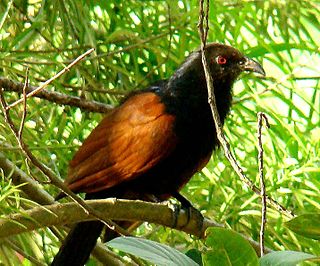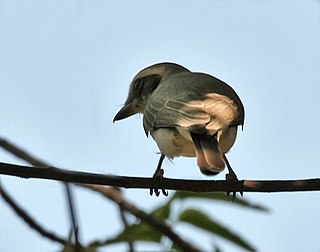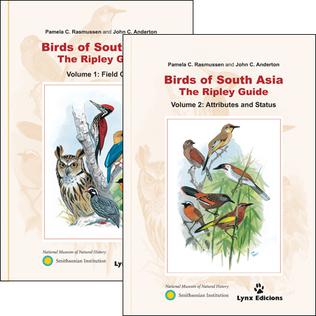
The family Vangidae comprises a group of often shrike-like medium-sized birds distributed from Asia to Africa, including the vangas of Madagascar to which the family owes its name. Many species in this family were previously classified elsewhere in other families. Recent molecular techniques made it possible to assign these species to Vangidae, thereby solving several taxonomic enigmas. The family contains 40 species divided into 21 genera.

The little swift, is a small species of swift found in Africa and southwestern Asia, and are vagrants and local breeders in southern Europe. They are found both in urban areas and at rocky cliffs where they build nests in a way typical of all members of the order Apodiformes. The genus name Apus is Latin for a swift, thought by the ancients to be a type of swallow without feet. The Latin specific affinis means similar to or related to, but in this case the species that the little swift supposedly resembles is not clear from the description. A population formerly considered to be an eastern subspecies of little swift is now separated as a distinct species, the house swift.

The besra, also called the besra sparrowhawk, is a bird of prey in the family Accipitridae.

The Sri Lanka blue magpie or Ceylon magpie is a brightly coloured member of the family Corvidae, found exclusively in Sri Lanka. This species is adapted to hunting in the dense canopy, where it is highly active and nimble. Its flight is rather weak, though, and is rarely used to cover great distances. In spite of the Sri Lanka blue magpie's ability to adapt to the presence of humans, it is classified as vulnerable to extinction due to the fragmentation and destruction of its habitat of dense primary forest in the wet zone of southern Sri Lanka.

The green-billed coucal is a member of the cuckoos. It is endemic to Sri Lanka's wet zone and listed as Vulnerable on the IUCN Red List, as the small population declined due to forest destruction and fragmentation. It inhabits the tall rainforests of southwest Sri Lanka and nests in bushes. Its typical clutch is 2–3 eggs.

The pompadour green pigeon is a pigeon species complex. It is widespread in forests of southern and southeast Asia. Many authorities have split the pompadour green pigeon into multiple species, which are listed below:

The orange-breasted green pigeon is a pigeon found across tropical Asia south of the Himalaya across parts of the Indian Subcontinent and Southeast Asia. Like other green pigeons, it feeds mainly on small fruit. They may be found in pairs or in small flocks, foraging quietly and moving slowly on trees. The nape is blue-grey and the crown is yellowish green. The uppertail coverts are bronzed and the undertail coverts are unmarked rufous. The male has a pinkish band on the upper breast with a broader orange one below while the female has a bright yellow breast.

The yellow-billed babbler is a member of the family Leiothrichidae endemic to southern India and Sri Lanka. The yellow-billed babbler is a common resident breeding bird in Sri Lanka and southern India. Its habitat is scrub, cultivation and garden land. This species, like most babblers, is not migratory, and has short rounded wings and a weak flight and is usually seen calling and foraging in groups. It is often mistaken for the jungle babbler, whose range overlaps in parts of southern India, although it has a distinctive call and tends to be found in more vegetated habitats. Its name is also confused with Turdoides leucocephala, which is also known as white-headed babbler.

The bar-winged flycatcher-shrike is a small passerine bird usually placed in the Vangidae. It is found in the forests of tropical southern Asia from the Himalayas and hills of southern India to Indonesia. Mainly insectivorous it is found hunting in the mid-canopy of forests, often joining mixed-species foraging flocks. They perch upright and have a distinctive pattern of black and white, males being more shiny black than the females. In some populations the colour of the back is brownish while others have a dark wash on the underside.

The Sri Lanka spurfowl is a member of the pheasant family which is endemic to the dense rainforests of Sri Lanka. In Sri Lanka, this bird is known as haban kukula - හබන් කුකුලා in Sinhala.

Jerdon's bush lark or Jerdon's lark is a species of lark in the family Alaudidae found in south Asia. This was formerly considered as a subspecies of Mirafra assamica and termed as the Madras bushlark. Two other species in the complex include Mirafra marionae and Mirafra microptera. Jerdon's bush lark is typically very pale on the underside

The common woodshrike is a species of bird found in Asia. It is now usually considered a member of the family Vangidae. It is small and ashy brown with a dark cheek patch and a broad white brow. It is found across Asia mainly in thin forest and scrub habitats where they hunt insects, often joining other insectivorous birds. The form found in Sri Lanka which was treated as a subspecies is now usually considered a separate species, the Sri Lanka woodshrike.

The black-winged flycatcher-shrike is a species of bird in the flycatcher-shrike genus, Hemipus. It is usually placed in the Vangidae. It is found in the Malay Peninsula and the Greater Sunda Islands. Its natural habitats are lowland forests and sometimes swamps and mangroves. The International Union for Conservation of Nature (IUCN) has assessed it as being of least concern.

The large woodshrike is found in south-eastern Asia, Sumatra, Java, and Borneo. Its natural habitats are temperate forest, subtropical or tropical moist lowland forest, subtropical or tropical mangrove forest, and subtropical or tropical moist montane forest.

Tephrodornis is a bird genus in the family Vangidae.

Birds of South Asia: The Ripley Guide by Pamela C. Rasmussen and John C. Anderton is a two-volume ornithological handbook, covering the birds of South Asia, published in 2005 by the Smithsonian Institution and Lynx Edicions. The geographical scope of the book covers India, Bangladesh, Pakistan, Sri Lanka, Nepal, Bhutan, Maldives, the Chagos Archipelago and Afghanistan. In total, 1508 species are covered. Two notable aspects of Birds of South Asia are its distribution evidence-base — the book's authors based their distributional information almost completely on museum specimens — and its taxonomic approach, involving a large number of species-level splits.

The Malabar woodshrike is a species of bird usually placed in the family Vangidae. It is found in western India. It is sometimes considered a subspecies of the large woodshrike.

Kaludiya Pokuna Archeological Forest Site is a forest with archeological remains in Kandalama, in the Dry Zone of Sri Lanka. The site has been handed over to the Girls' High School, Kandy in accordance with the "Urumaya Thani Nokaramu" program organized by the Department of Archeology. For the first time in Sri Lanka, a school was given custody of an archeological site.



















